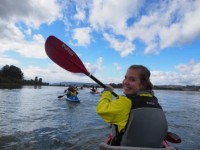On Friday, October 31, 2014 (Happy Halloween!) Columbia Riverkeeper joined over 400 citizens in speaking up for our Columbia River. We demanded a comprehensive Environmental Impact Statement (EIS) that assesses all the impacts and risks of major industrial development on the Columbia River in Columbia City, Oregon promoted by the Port of St. Helens. Our actions are in response to the Port of St. Helens' request for federal funding to conduct a Columbia City Industrial Park Maritime Feasibility Study. The proposed study lacks long term vision and could pave the way for future dirty fossil fuel shipment and export. Port only reveals plans to use federal funds to study dock construction, dredging in the Columbia, and increased rail traffic.
Columbia City is located directly on the river in the Columbia River Estuary, a federally-designated Estuary of National Significance under the Clean Water Act’s National Estuary Program. The Columbia River was designated in 2006 as one of the U.S. Environmental Protection Agency’s seven Priority Large Aquatic Ecosystems. Multiple studies and publications have identified the Columbia River Estuary as vitally important for juvenile salmonid rearing and endangered species recovery. Development in riparian areas and shallow-water habitats, dredging, and in- and over-water structures like piers and docks have significantly degraded the Columbia River Estuary’s ability to support juvenile salmonids.
The Port of St. Helens has a track record of keeping communities in the dark and courting dirty, dangerous, and highly controversial developments like crude oil-by-rail and two coal export facilities. Only one public hearing was held before the Port approved a now-defunct coal export proposal that would have brought 16 coal trains a day through the region. Additionally, the Port never gave the public the chance to weigh in on the transition of an ethanol facility to a dangerous crude oil terminal.



